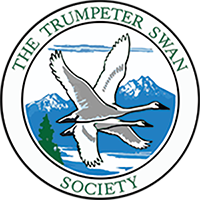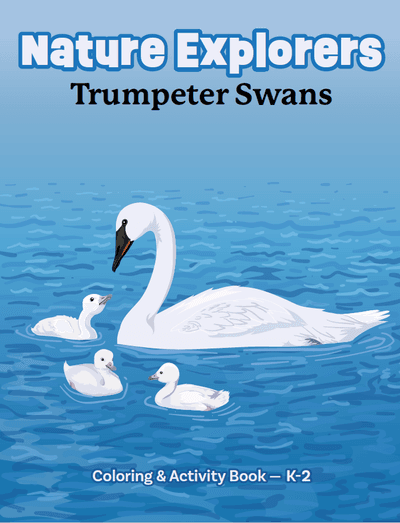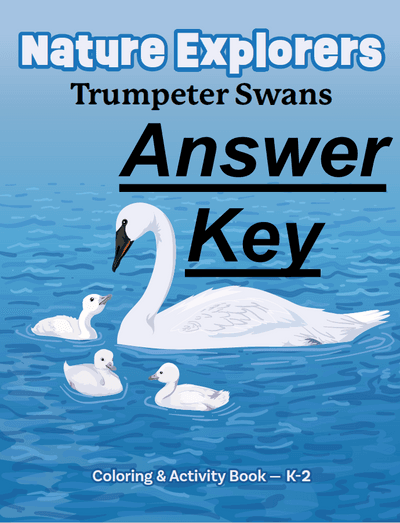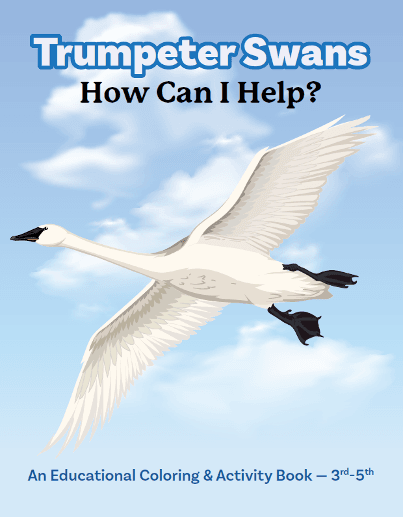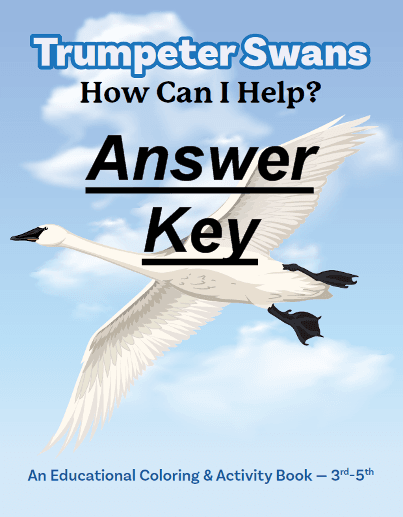Photograph by Margaret Smith
Resources for Teachers
-
"Nature Explorers" -With this fun and educational activity book, a young child will learn about trumpeter swans and their wetland home!
The book is based on Next Generation Science Standards (NGSS) and is designed for classroom learning too.
"Nature Explorers" explores the world of trumpeter swans. Learn about their large size and spring and fall migrations. Discover their adaptations and what makes a healthy wetland home.
There are QR codes to listen to the sounds of trumpeter swans, watch them fly in and land, and see a trumpeter swan family.
There is also an Answer Key that can be downloaded separately.
-
Download the standards for classroom and home schooling use!
-
"Trumpeter Swans- How Can I Help?" explores the many ways people help swans and their habitats. Meet the people who take care of wildlife, study birds, keep water clean and stop flooding, have fun programs at zoos, design collars that track swans and more!
Solve the Maze of Dangers, track a swan, do a Wetland Word Search and much more!
There are QR codes that will take you to lots of fun videos and web pages to learn even more!
-
Download the standards for classroom and home schooling use!
-
Above: This Activity and Information booklet from the Iowa Restoration Program/Iowa Department of Natural Resource should be your first go-to guide to learn about and teach about trumpeter swans and wetland habitat.
It contains fantastic background information about trumpeter swans, threats, habitat needs and so much more. There are many activities from constructing a wetland, "Migration headaches", "Water Canaries", "Wetland Metaphors", the "Year of the Trumpeter Swan" and more.
-
Education World: Subject: Science; Grade: 3
Lesson Objective: To learn about the life cycle of trumpeter swans and then answer questions about the life cycle.
Includes material sources including a printable student handout, and link to Maryland Zoo Trumpeter Swan life cycle page. -
This is a selection of great resources for teaching about birds and birding put together by Environmental Education in Wisconsin
-
What do Trumpeter Swan feathers look like? Check out this site. You can also type in the names of other birds to see what their feathers look like. This website promotes feather identificaton, research, and appreciation by providing high-resolution scans of the flight feathers of North American birds. Use "Search scans" to see the feathers of up to 396 bird species. For each species, the Feather Atlas typically illustrates all the primaries (outer wing feathers; usually 10), 10-12 secondaries (inner wing feathers), and six rectrices (tail feathers) from an individual bird.
-
This paper, while written in scientific language, has excellent background information about Trumpeter Swans in its first 4 pages.
-
This list of historic references and quotes about swans was compiled by Dr. Donald A. Hammer. It includes references by Lewis and Clark, John James Audubon, and a host of explorers across North America.
-
All students in kindergarten through grade twelve are encouraged to participate in the Junior Duck Stamp Conservation and Design Program annual art and conservation message contest as part of the Junior Duck Stamp Program curriculum. The Junior Duck Stamp Art Contest is the culmination of the Junior Duck Stamp educational program. After studying waterfowl anatomy and habitat, students may express their newfound knowledge by drawing, painting or sketching a picture of an eligible North American waterfowl species.
Because students express themselves best in different formats, the conservation message contest gives them an opportunity to use the written word to express their knowledge. Students from across the United States submit their artwork to their state, territory or district competition.
-
Check out the Journal Entries for Patrick Gass for October 30, 1805, November 4, 5, and 8, 1805.
October 30, 1805 near tidewater on the Columbia River, "On our way down we saw a great many swans, geese and ducks…."
November 4, 1805 same place: "We also passed a number of Indian lodges; and saw a great many swans, geese, ducks, cranes and gulls."
November 5, 1805 same place: "At noon we stopped about an hour at an island, and some of the men went out and killed nine brants and a swan."
November 8, 1805 same place: "In it there are a great many swans, geese, ducks and other water fowls."
